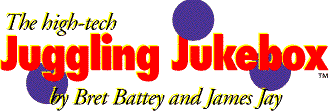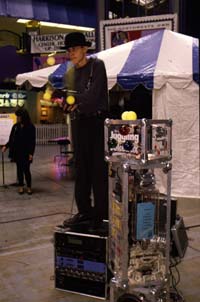|
Overview |
Technical Details |
Art Pretense |
Songs |
Gallery |
Credits

Song Descriptions
The juggling generally avoids the normal three-ball cascade and builds phrases based on other continous patterns like the shower, columns, or James Jay's own inventions. Some of the juggling descriptions below will be decipherable only by jugglers, but glean from it what you may.
The music exhibits a wide variety of textures and techniques which reinforce and comment on the dramatic essences of the juggling routines.
Songs are priced according to the number of balls involved. A typical performance would be programmed for (in U.S. dollars): 3 balls, $.95; 4 balls, $1.90; and 5 balls, $4.85. The odd numbers give the audience a modest thrill ("This thing even makes change!").

- Water Clock (3 balls)
- Pendulum motions and arm circles form the foundation for the juggling, which culminates in a weave/btb pattern.
- The static drama of a cycling clock is reinforced by algorithmic melodies which cycle endlessly while providing an aural illusion of continuous climbing.
- Ionic Collonade (3 balls)
- The juggling consists of a collection of columns variations and the Boston Mess, and ends with chops.
- The sound material is reminiscent of gamelan in terms of timbre and structure. Cycling bell sequences (samples of fence post drivers, struck titanium tubes, and power saw blades) follow the rhythmic columns of the jugging act and punctuate phrase points with fundamental tones and harmonic shifts.
- Astrolabe #7 (3 balls)
- The shower pattern is the juggling foundation. Tricks that grow out of it include high throws with ball-position changes and the box. The routine ends with a typewriter-return sequence.
- The shower rhythm of the juggling pattern inspired a score reminiscent of spy movie soundtracks. The opening juggling pattern and musical pattern are of different lengths. The result is an unpredictable phasing effect between the rhythmic cycle and the chord cycle. When the phase finally resolves with the establishment of a motor rhythm by the right hand, the classic entry of walking jazz bass with ride cymbal firmly establishes the James Bond sensibility. James Jay's favorite 3-ball piece, musically.
- Blind Grab (3 balls)
- This trick seems to be the most popular selection. The title refers to the climax trick--a head roll off the back of the head with a behind-the-back blind catch.
- The musical material uses chaotic feedback algorithms to provide a continually varying percussive accompaniment to the juggling. The drop of the ball from the head is matched by a downward gesture of marimba-like tones.
- Liberty (3 balls)
- The routine draws its name from the standard Statue of Liberty juggling trick. "Liberty" also features James Jay's signature trick--back of hand catches knocked off by claw catches and vice versa.
- A predetermined 8-measure chord sequence is decorated algorithmically by routines that follow the tempo of the juggling.
- Circus Wagon (4 balls)
- This song progresses from an in-sync fountain with occasional high tosses (the site swap is 4-4-4-8-4-2-4-4) through a half shower to a full shower. The finale is a 2-ball carry, weave and drop. And catch--that's the hard part.
- "Circus Wagon" is the most sophisticated piece in terms of musical tempo tracking, controlling a dense, 4 to 6 voice extrapolation of a chord pattern through regular juggling patterns interrupted by high tosses. Chaotic feedback algorithms control variations between 2, 3, and 4 divisions of the beat for each voice. Musically, this is Bret Battey's personal favorite.
- Alternate Currents (4 balls)
- This song starts with some basic multi-plexing. The rest is based on an off-sync fountain, with tennis throws and behind-the-backs (with the same ball, echoing the tennis pattern) as embellishment.
- The music for this piece is the most "techno," featuring mechanical pounding and drones, punctuated by whines of a drill and hammering metal.
- Shrove-Tide Fair (5 balls)
- The flashiest piece. After some fake starts, the song starts with five-ball multiplexing. After a few tricks (under-the-leg and behind-the-back both ways), the pattern is thrown up into the five-ball cascade. After a half-shower, the pattern switches back to a 2-up/3-up multiplex. Back in the cascade pattern, the finale is a high throw caught back into the pattern (8-5-5-2-5).
- The choice of orchestration, harmonic material, and arpeggiated textures that accompany the juggling was inspired by the vision of a revised opening tableau for Stravinsky's ballet Petrouchka, in which a juggler joins the organ grinder and tipsy merrymakers. Or, was it based on Ravel?
Juggling (C) 1994 by James Jay. Music (C) 1994 by Bret Battey.
The descriptions above (as well as the video) serve as copyrights for the juggling routines. Flame-mail from anti-proprietary, free-pattern jugglers welcome.
The high-tech Juggling Jukebox by Bret Battey and James Jay
Overview |
Technical Details |
Art Pretense |
Songs |
Gallery |
Credits
"Juggling Jukebox" is a trademark of James Jay.
|
